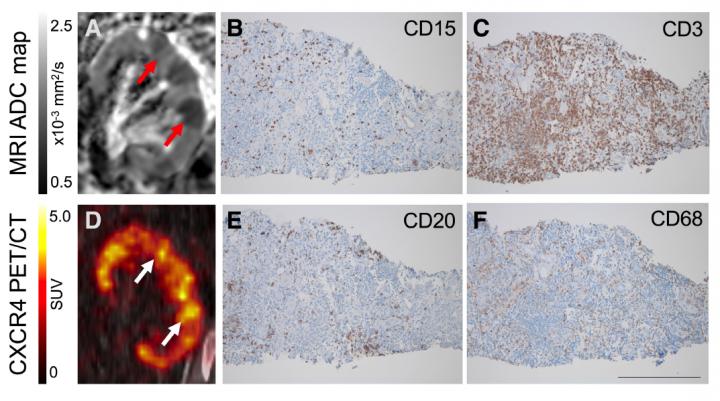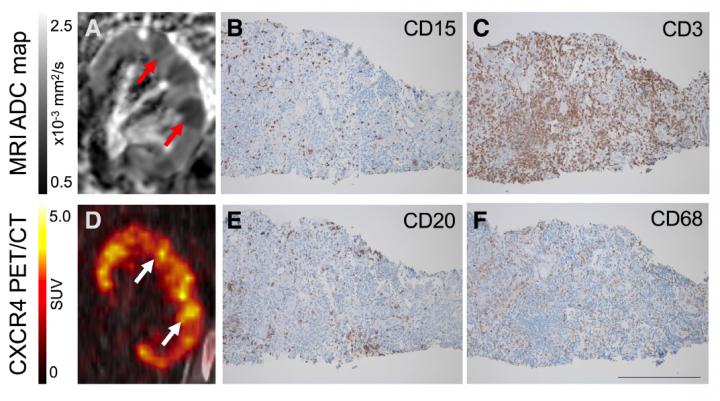
Credit: T Derlin et al., Hannover Medical School, Hannover, Germany
RESTON, Va. – German scientists have developed a novel nuclear medicine test that can determine whether a kidney transplant patient has developed infection in the transplanted tissue. The study, which utilizes positron emission tomography/magnetic resonance imaging (PET/MRI), is presented in the December issue of The Journal of Nuclear Medicine.
Complicated urinary tract infections (UTIs) occur frequently in patients after kidney transplantation due to suppression of the immune system and may lead to transplant failure or sepsis. Detecting the source and extent of infection–especially whether the transplanted kidney (allograft) is involved–without further invasive procedures can be challenging.
This study is the first application of highly-specific CXCR4-targeted PET using gallium-68 (68Ga)-Pentixafor for imaging infection. CXCR4 is a small receptor protein present on leukocytes (white blood cells) fighting infection, and CXCR4 orchestrates the recruitment of infiltrating leukocytes to the site of infection.
"Direct visualization of infiltrating leukocytes in renal allografts in the context of kidney infection has not been done before using PET," explains Thorsten Derlin, MD, Department of Nuclear Medicine, Hannover Medical School, Hannover, Germany. "Other imaging methods have not been very useful in the past for diagnosing renal infection, and biopsy may have complications, including bleeding."
For the study, 13 kidney transplant recipients with complicated UTIs underwent PET with the CXCR4-ligand 68Ga-Pentixafor and diffusion-weighted MRI. The combined PET/MRI detected acute infection in the transplanted kidneys of 9 patients and lower UTI/non-urological infections in the remaining 4 patients.
Combined CXCR4-targeted PET/MR imaging with 68Ga-Pentixafor, therefore, shows strong potential for noninvasive detection of leukocytes in kidney transplants. This novel methodology may also refine the characterization of infectious and inflammatory kidney diseases and may serve as a platform for future clinical studies targeting transplanted tissue (allograft) infection.
"This work establishes CXCR4-targeted PET as a novel approach for imaging of infection, and it strengthens the role of nuclear medicine for renal imaging," Derlin states. "It demonstrates the potential of integrating state-of-the art imaging approaches–i.e., diffusion-weighted MRI and novel, highly specific PET tracers–for a comprehensive assessment of kidney disease and has the potential to be translated into other settings of difficult-to-diagnose infections, such as cholangitis in transplanted patients and bone infections."
###
Authors of "Integrating MRI and chemokine receptor CXCR4-targeted PET for detection of leukocyte infiltration in complicated urinary tract infections after kidney transplantation" include Thorsten Derlin, Faikah Gueler, Jan Hinrich Bräsen, Jessica Schmitz, Dagmar Hartung, Thomas R. Herrmann, Tobias L. Ross, Frank Wacker, Marcus Hiss, Hermann Haller, Frank M. Bengel, and Katja Hueper at Hannover Medical School, Hannover, Germany, and Hans-Jürgen Wester at Technical University, Munich, Germany.
Please visit the SNMMI Media Center to view the PDF of the study, including images, and more information about molecular imaging and personalized medicine. To schedule an interview with the researchers, please contact Laurie Callahan at (703) 652-6773 or [email protected] Current and past issues of The Journal of Nuclear Medicine can be found online at http://jnm.snmjournals.org.
About the Society of Nuclear Medicine and Molecular Imaging
The Society of Nuclear Medicine and Molecular Imaging (SNMMI) is an international scientific and medical organization dedicated to raising awareness about nuclear medicine and molecular imaging, vital elements of precision medicine that allow diagnosis and treatment to be tailored to individual patients in order to achieve the best possible outcomes.
SNMMI's more than 15,000 members set the standard for molecular imaging and nuclear medicine practice by creating guidelines, sharing information through journals and meetings and leading advocacy on key issues that affect molecular imaging and therapy research and practice. For more information, visit http://www.snmmi.org.
Media Contact
Laurie Callahan
[email protected]
@SNM_MI
http://www.snm.org
Original Source
http://www.snmmi.org/NewsPublications/NewsDetail.aspx?ItemNumber=25476 http://dx.doi.org/10.2967/jnumed.117.193037





